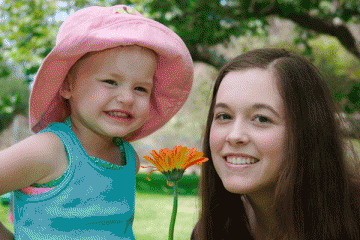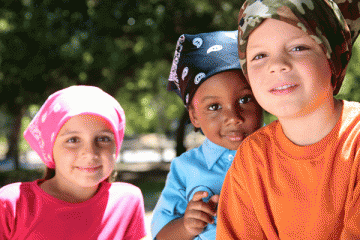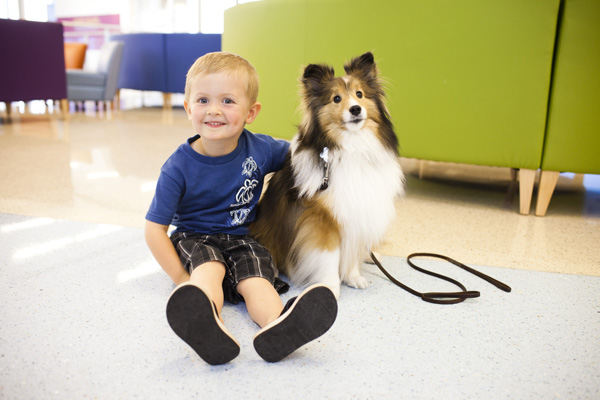Blood and Marrow Transplant Program
The Hyundai Cancer Institute at CHOC Blood and Marrow Transplantation (BMT) Program is made up of a team of highly trained oncology experts, including two dedicated nurse coordinators who assist patients and their families through the transplant process. The majority of children who may benefit from a blood or bone marrow transplant are those with leukemia, including acute lymphoblastic leukemia (ALL) and acute myelogenous leukemia (AML). Other conditions that may respond to transplantation include hematologic disorders such as immune deficiencies and aplastic anemia, Hodgkin’s and non-Hodgkin’s lymphoma, Ewing’s sarcoma and solid tumors including some brain tumors and neuroblastoma.
The Hyundai Cancer Institute BMT Program is the only pediatric blood and bone marrow transplant program in Orange County and offers a full range of transplant procedures and services. In addition to performing all necessary tests and procedures prior to the transplant, we test immediate family members (siblings and parents) to see if they are a match for the patient. (For more information on testing extended family members, please see the questions and answers below about the blood and marrow transplant process.)
What is a pediatric blood or bone marrow transplant?
A blood or marrow transplant (BMT) is a special therapy for patients with certain cancers or other diseases. A transplant replaces unhealthy blood-forming cells with healthy ones. To prepare for the transplant, patients may be given strong chemotherapy and/or radiation therapy. These treatments kill the unhealthy cells. Healthy blood-forming cells (stem cells) are then given to the patient in a vein much like a blood transfusion. The transplanted stem cells begin to grow and make the red blood cells, white blood cells and platelets the body needs. This is called engraftment. Engraftment typically takes two to four weeks. Until the transplanted cells have engrafted, patients stay in the hospital.
The goal of a blood or bone marrow transplant is to cure many diseases and types of cancer. When a child’s bone marrow has been damaged or destroyed due to a disease or intense treatments of radiation or chemotherapy for cancer, a transplant may be needed. A blood or marrow transplant can be used to:
- Replace diseased, non-functioning bone marrow with healthy functioning bone marrow for conditions such as leukemia, aplastic anemia and sickle cell anemia.
- Replace the bone marrow and restore its normal function after high doses of chemotherapy or radiation are given to treat a malignancy. This process is often called “rescue” and used for diseases including lymphoma and neuroblastoma.
- Replace bone marrow with genetically healthy functioning bone marrow to prevent further damage from a genetic disease process such as Hurler’s syndrome and adrenoleukodystrophy disorder.
Types of bone marrow transplants:
There are two different types of bone marrow transplants:
- Autologous BMT is an infusion of the patients’ stem cells.
- Allogeneic BMT is an infusion of a donor’s stem cells.
This person may be either a family member (related donor) or an unrelated donor. Related donors who are brothers or sisters and share the same parents have the highest chance of being a suitable donor since they may have inherited the same tissue type from their parents. Occasionally, a parent or an extended family member (half-siblings, cousins, etc.) is a donor match. Unfortunately, in many cases, parents may not be a good enough match to be their child’s donor.
Pediatric Blood and Bone Marrow Transplant services we offer:
- Autologous bone marrow transplant
Transplant in which the patient receives his or her own bone marrow. - Allogeneic bone marrow transplant
Bone marrow transplant with marrow from a person other than the patient. The marrow may come from a related donor (such as a sibling) or an unrelated donor. - CAR-T Cell Program
Cellular immunotherapy that involves the collection and genetic modification of a patient’s own T-cells. - Peripheral blood stem cell transplant
In this process, the patient receives his or her own peripheral stem cells (autologous) or stem cells from a related donor (allogeneic). - Umbilical cord blood transplant
In this procedure, blood is collected from the placenta after the umbilical cord is separated from a newborn baby. This blood contains large numbers of bone marrow stem cells and can be used as a source of donor cells from a sibling or unrelated donor for a bone marrow transplant.
Blood and Bone Marrow Transplant Recovery
As with any procedure, such as bone marrow transplant, prognosis and long-term survival can vary greatly from child to child. The amount of transplants occurring for an increased number of diseases, coupled with medical developments, has greatly improved the outcome for bone marrow transplant in children and adults. Continuous follow-up care is essential for the child following a transplant. New methods to improve treatment and to decrease complications and side effects of transplant are continually being discovered.
Blood and Bone Marrow Transplant Risks
Blood and marrow transplants have risks involved, some of which are life threatening. The risks and benefits must be weighed in a thorough discussion with the transplant team prior to the procedure. Each child experiences diseases differently and a transplant may not be appropriate for everyone who suffers from these diseases. Some of the diseases that have been treated with blood and marrow transplant include the following:
- Leukemia
- Lymphomas
- Some solid tumors (i.e., neuroblastoma, rhabdomyosarcoma, brain tumors)
- Aplastic anemia
- Immune deficiencies (severe combined immunodeficiency disorder, Wiskott-Aldrich syndrome)
- Sickle cell disease
- Thalassemia
- Diamond-Blackfan anemia
- Metabolic/storage diseases (i.e., Hurler’s syndrome, adrenoleukodystrophy disorder)
- Cancer of the kidneys
Infections are common in children with severe bone marrow suppression. Blood tests are performed to prevent, detect and treat infections. Antibiotics, anti-fungal medications and anti-viral medications are often given to prevent serious infection. Bacterial infections are the most common and viral and fungal infections can be life threatening. Any infection can cause an extended hospital stay, prevent or delay engraftment, and/or cause permanent organ damage.
Preventative measures for common sources of infection are also a part of transplant. This may include any or all of the following: special air filtered rooms, diet restrictions, isolation requirements, restriction of visitors, strict hygiene regimen, frequent linen changes. Other complications can include: low platelets and low red blood cells, pain, fluid overload, respiratory distress, organ damage, graft failure, graft-versus-host disease.
CHOC’s BMT Team
A team of specially trained BMT experts guides each patient and his or her family throughout the BMT process. At CHOC, our BMT team is made up of:
- Blood and Marrow Transplant Medical Director Rishikesh Chavan, M.D., is the pediatric BMT physician who specializes in the care of children undergoing a BMT.
- A group of pediatric hematologists/oncologists assist in the day-to-day medical management of the children during the BMT process.
- BMT Coordinators Our BMT nurse coordinators organize all aspects of care provided to our patients before and after the transplant. They provide patient education, coordinate diagnostic testing and assist with follow-up care and home care needs.
- Social Workers Our social workers provide support to patients and their families to help them deal with the many issues that may arise, including lodging and transportation, finances and legal issues.
- Dietitians Our clinical dieticians assist patients in meeting their nutritional needs before and after the transplant. They work closely with patients and their families to provide nutritional education and suggestions if any nutritional problems arise. Our diet technicians help patients and their families select the patient’s daily food menu and work on any reasonable special requests while patients are in the hospital.
- Psychologists Specially trained psychologists help patients and their families with the emotional aspects of cancer. The psychology staff is dedicated to increasing opportunities for children with cancer and their families to live normal lives during and after hospitalization. Child Life Therapists The Child Life staff provides a wide variety of therapeutic programs to help the patients develop their social, emotional, and cognitive skills. Through play, children learn self-expression, decision-making, creativity and motor development.
- Blood and Donor Services Nursing Staff Registered nurses who are specially trained in apheresis technology and blood collection are with our patients every step of the way. They coordinate and provide nursing care for the blood donor during the entire donation process and for the patient undergoing apheresis procedures.
- Case Coordinator Our case coordinator nurses follow each child’s case and make recommendations for optimal utilization of resources.
- Classroom Teacher A credentialed teacher employed by the Orange Unified School District helps patients maintain their academics during hospitalization.
- Clinical Nurse Specialist A nurse that has a master’s degree in nursing and has specialized training in Pediatric Oncology/BMT works closely with the nursing staff and doctors to help develop a plan of care for the patient.
- Nurse Practitioner Under the direction of the oncologist, the nurse practitioner performs physical examinations as well as diagnostic and therapeutic procedures.
- Radiation Oncologist The radiation oncologist is the physician who evaluates each child’s need for radiation therapy.
Other team members will evaluate the child before transplantation and will provide follow-up care, as needed. These include, but are not limited to, the following: Nursing Staff, Pharmacists, Respiratory Therapists, Physical Therapists, Lab Technicians, Infectious Disease specialists, Dermatologists, Gastroenterologists, Chaplain
For many cancers, a blood or bone marrow transplant may be part of a child’s treatment plan.
Israel's Story

Israel, a standout athlete, spent his junior year of high school fighting cancer and returned home just before the onset of COVID-19. Now a senior, he’s working to get back on the football field and grateful to have his cancer journey behind him.
For Dr. Chavan, pediatric oncologist and director of CHOC’s Blood and Marrow Transplant Program, Israel’s excellent recovery from his BMT is a shining example of how most BMT patients eventually resume normal lives.
“A lot of people think of a transplant as a big, bad thing,” Dr. Chavan says.
With the proper medical care, it’s not.
“When you look at Israel today,” Dr. Chavan says, “you would not be able to tell that he had a bone marrow transplant just eight months ago.”
Frequently Asked Questions About Pediatric Blood or Bone Marrow Transplant
Every type of blood cell in the bone marrow begins as a stem cell. Stem cells are immature cells that are able to produce other blood cells that mature and function as needed. Stem cells are the most important cells needed in a blood and bone marrow transplant. Stem cells, when transplanted, find their way to the recipient's marrow and begin to differentiate and produce all types of blood cells that are needed by the body. Healthy stem cells come from three different sources:
- Bone marrow is sponge-like tissue that fills the hollow space inside bones. The bone marrow is responsible for the development and storage of most of the body's blood cells. This tissue contains the stem cells that produce red blood cells, white blood cells, and platelets. When a portion of a person’s bone marrow is collected for transplantation, it is called a “bone marrow harvest.”
- Peripheral blood is blood that circulates in the blood stream. Peripheral blood contains the same blood producing cells that are present in bone marrow. When a person’s peripheral stem cells are collected for transplantation, it is called a “peripheral blood stem cell collection” or “apheresis”.
- Umbilical cord blood is found in the umbilical cord of a newborn baby and is a rich source of stem cells that can be used in transplantation. Cord blood is collected from the umbilical cord of a newborn baby immediately after delivery. Once the cord blood has been collected, it is frozen and stored at a cord blood bank for future use. The stored cord blood is called a “cord blood unit (CBU).” Cord blood collection is a non-invasive procedure that is not harmful to either the mother or baby.
- are tested for infectious diseases such as AIDS and hepatitis.
- answer questions about their health history. This helps doctors find risks if the donors have an infectious or hereditary disease.
- iare checked by doctors for signs of disease.
Marrow and cord blood donations are thoroughly screened, much the same as regular blood donations. Even so, donated whole blood cannot be guaranteed 100% free of infectious diseases. In the same way, the risk that donated blood or marrow cells carry a disease cannot be completely eliminated.
Supportive care is given to prevent and treat infections, side effects of treatments, and complications. This includes frequent blood tests, close monitoring of vital signs, strict measurement of input and output, weighing the child daily (or twice daily), and providing a protected and sterile environment. The days before transplant are counted as minus days. The day of transplant is considered day 0. Engraftment and recovery following the transplant are counted as plus days. For example, a child may enter the hospital on day -8 for preparative regimen. Days +1, +2, etc., will follow. There are specific events, complications, and risks associated with each day before, during, and after transplant. The days are numbered to help the child and family understand where they are in terms of risks and discharge planning. Depending on the type of transplant and the disease being treated, engraftment usually occurs around day +15 or +30.
During infusion of bone marrow, the child may experience some or all of the following symptoms:
- nausea / vomiting
- chills
- fever
- hives
- chest pain
- discomfort
After infusion, the child may:
- spend several weeks in the hospital.
- be very susceptible to infection.
- experience excessive bleeding.
- have blood transfusions.
- be confined to an environment that will prevent them from being infected from sick people. take multiple antibiotics and other medications.
- be given medication to prevent graft-versus-host disease (if the transplant was allogeneic). The transplanted new cells (the graft) tend to attack the child's tissues (the host), even if the donor is a relative, such as a brother, sister, or parent.
- undergo continual laboratory testing.
- experience nausea, vomiting, diarrhea, mouth sores and extreme weakness.
- experience temporary emotional or psychological distress.
Understanding the Blood and Marrow Transplant Process
Extended family members and friends can donate umbilical cord for specific patient use; however, this is considered private banking, is subject to a storage fee and must be collected at St. Joseph Hospital next to CHOC. It is recommended that umbilical cords from infants born at St. Joseph Hospital be donated for public use through the national registry. For more information, please contact the CHOC Cord Blood Bank at (714) 509-4335.
- Prior to the transplant, an extensive evaluation is completed by the Blood and Marrow Transplant (BMT) team. All other treatment options are discussed and evaluated for risk-versus-benefit.
- A complete medical history and physical examination are performed, including multiple tests to evaluate the child's blood and organ functions (i.e., heart, kidney, liver, lungs).
- A child will often come to the CHOC BMT center seven to 14 days prior to transplant for hydration, evaluation, placement of a catheter (also called a "central venous line") and other preparations. The central venous line is surgically placed in a vein in the chest area. Blood products and medications will be administered through the catheter.
- A suitable (tissue-typed and matched) donor must be available.
- extent of engraftment,
- presence of complications,
- the patient’s overall health, and
- suitable living arrangement must be available within a 50 mile radius from the hospital.

















